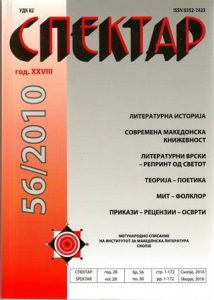ИГРАТА НА СПЕКТАТОРОТ ВО ОТКРИВАЊЕТО НА ДРУГОСТА И ПОТРАГАТА ПО СОПСТВЕНИОТ ИДЕНТИТЕТ
THE PLAY OF THE SPECTATOR IN DISCOVERING THE OTHERNESS AND SEARCHING AFTER OWN IDENTITY
Author(s): Nikolinka NolevskaSubject(s): Identity of Collectives
Published by: Институт за македонска литература
Keywords: Otherness; identity; Kujundiski
Summary/Abstract: The identity and identity searching present a process which occupies the human beans nowadays. New age streams of deconstruction and the new explanations about symbols and symbolism of human existence changed the positions which gave the answer to the question: What means the term identity? The essentialist theory says that the identity is ones and for ever given and presents constant structure. This theory is fusty long ago. The new one, the constructivist theory for identity says that every narration is conditioned by the existentialist position or by the status of the narrator or the author. Promoting the principle of dynamism, dialectics, changeability, the new theories survey the identity between new age cultural frames. They take, in their outline, different aspects of analyses and various elements which compose the human life. The component – searching for identity, could be look for in every story, happening or discourse like a part of the global processes in which human being exists. Searching for the basic assumptions in Lakan`s theory of identity, over the play of the mirror and reflection of the image in it, we come to the most important point of refraction: changing the mirror I to the society I. Is the mirror play ending in that moment, or is it following the human individual living in the processes of transition, society and culture accommodation, habitualisation and finding the Otherness, or the Other? The mirror and its forms (natural: the water, the eye, or artificial: the magnifying-glass, the glasses, the binocular, the window, the camera, the monitor of the TV set, the book) are the mediums through which the individual finds its own identity and its own alterego. The road to the knowing and to the self-finding leads through the ambivalent, polarized structures, through the binary oppositions which dominate especially in gender identity. The human`s picture about the world is full with stereotypes, clichés and prejudices, and it generates deformed vision in the subject who observes himself in the framed mirror surface. That is the most dangerous moment when the individual turns itself from the subject to the object, as a victim of the manipulations, stigmatization and influences. The stories offer to survey the processes about building separate identities, through different components which are conceiving as human triviality or a habit. But in fact, they permit deeper understanding of the hronotopy of the presence: - The love (as mythical exploration about the part which is missing to close the story about the self identity and about the essence of the life) - The stereotypes which imposes the mechanism of patriarchal society which builds the gender identity and imposes the differences between sexes. - Existential and material elements which take part in building the identity: the house, the apartment, the interior, the objects, the habits, analyzed through the concepts of Bachelard (and the water and its variations through Hoffman`s and Swrnbourn`s complexes). The structure of the novel is symbolic too. The chain of stories, that is the limited space, in which the people are doomed to manoeuvre and searching for the reasons of selfexisting. That chain brakes in the moment when the human starts to observe himself from the different point of view, when he stars to discover himself, and through that process began to become conscious about the Other and about his own identity.
Journal: Спектар
- Issue Year: 2010
- Issue No: 56
- Page Range: 46-58
- Page Count: 13
- Language: Macedonian

